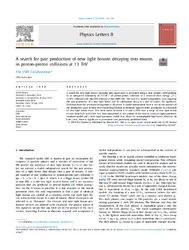A search for pair production of new light bosons decaying into muons in proton-proton collisions at 13 TeV
| dc.contributor.author | Sirunyan, A. M. | |
| dc.contributor.author | Işıldak, Bora | |
| dc.date.accessioned | 2020-07-01T06:36:48Z | |
| dc.date.available | 2020-07-01T06:36:48Z | |
| dc.date.issued | 2019-09-10 | |
| dc.identifier.issn | 0370-2693 | en_US |
| dc.identifier.uri | http://hdl.handle.net/10679/6675 | |
| dc.identifier.uri | https://www.sciencedirect.com/science/article/pii/S0370269319304691 | |
| dc.description.abstract | A search for new light bosons decaying into muon pairs is presented using a data sample corresponding to an integrated luminosity of 35.9 fb(-1) of proton-proton collisions at a center-of-mass energy root s = 13 TeV, collected with the CMS detector at the CERN LHC. The search is model independent, only requiring the pair production of a new light boson and its subsequent decay to a pair of muons. No significant deviation from the predicted background is observed. A model independent limit is set on the product of the production cross section times branching fraction to dimuons squared times acceptance as a function of new light boson mass. This limit varies between 0.15 and 0.39 fb over a range of new light boson masses from 0.25 to 8.5 GeV. It is then interpreted in the context of the next-to-minimal supersymmetric standard model and a dark supersymmetry model that allows for nonnegligible light boson lifetimes. In both cases, there is significant improvement over previously published limits. | en_US |
| dc.description.sponsorship | BMBWF and FWF (Austria); FNRS and FWO (Belgium); CNPq, CAPES, FAPERJ, FAPERGS, and FAPESP (Brazil); MES (Bulgaria); CERN; CAS, MOST, and NSFC (China); COLCIENCIAS (Colombia); MSES and CSF (Croatia); RPF (Cyprus); SENESCYT (Ecuador); MoER, ERC IUT, and ERDF (Estonia); Academy of Finland, MEC, and HIP (Finland); CEA and CNRS/IN2P3 (France); BMBF, DFG, and HGF (Germany); GSRT (Greece); NKFIA (Hungary); DAE and DST (India); IPM (Iran); SFI (Ireland); INFN (Italy); MSIP and NRF (Republic of Korea); MES (Latvia); LAS (Lithuania); MOE and UM (Malaysia); BUAP, CINVESTAV, CONACYT, LNS, SEP, and UASLP-FAI (Mexico); MOS (Montenegro); MBIE (New Zealand); PAEC (Pakistan); MSHE and NSC (Poland); FCT (Portugal); JINR (Dubna); MON, ROSATOM, RAS, RFBR, and NRC KI (Russia); MESTD (Serbia); SEIDI, CPAN, PCTI, and FEDER (Spain); MoSTR(Sri Lanka); Swiss Funding Agencies (Switzerland); MST (Taipei); ThEPCenter, IPST, STAR, and NSTDA (Thailand); TUBITAK and TAEK (Turkey); NASU and SFFR (Ukraine); STFC (United Kingdom); DOE and NSF (USA). Individuals have received support from the Marie-Curie program and the European Research Council and Horizon 2020 Grant, contract No. 675440 (European Union); the Leventis Foundation; the A. P. Sloan Foundation; the Alexander von Humboldt Foundation; the Belgian Federal Science Policy Office; the Fonds pour la Formation a la Recherche dans l'Industrie et dans l'Agriculture (FRIA-Belgium); the Agentschap voor Innovatie door Wetenschap en Technologie (IWT-Belgium); the F.R.S.-FNRS and FWO (Belgium) under the "Excellence of Science - EOS" - be.h project n. 30820817; the Ministry of Education, Youth and Sports (MEYS) of the Czech Republic; the Lendulet ("Momentum") Program and the Janos Bolyai Research Scholarship of the Hungarian Academy of Sciences, the New National Excellence Program UNKP, the NKFIA research grants 123842, 123959, 124845, 124850 and 125105 (Hungary); the Council of Science and Industrial Research, India; the HOMING PLUS program of the Foundation for Polish Science, cofinanced from European Union, Regional Development Fund, the Mobility Plus program of the Ministry of Science and Higher Education, the National Science Center (Poland), contracts Harmonia 2014/14/M/ST2/00428, Opus 2014/13/B/ST2/02543, 2014/15/B/ST2/03998, and 2015/19/B/ST2/02861, Sonata-bis 2012/07/E/ST2/01406; the National Priorities Research Program by Qatar National Research Fund; the Programa Estatal de Fomento de la Investigacion Cientifica y Tecnica de Excelencia Maria de Maeztu, grant MDM-2015-0509 and the Programa Severo Ochoa del Principado de Asturias; the Thalis and Aristeia programs cofinanced by EU-ESF and the Greek NSRF; the Rachadapisek Sompot Fund for Postdoctoral Fellowship, Chulalongkorn University and the Chulalongkorn Academic into Its 2nd Century Project Advancement Project (Thailand); the Welch Foundation, contract C-1845; and the Weston Havens Foundation (USA). | |
| dc.language.iso | eng | en_US |
| dc.publisher | Elsevier | en_US |
| dc.relation.ispartof | Physics Letters B | |
| dc.rights | openAccess | |
| dc.title | A search for pair production of new light bosons decaying into muons in proton-proton collisions at 13 TeV | en_US |
| dc.type | Article | en_US |
| dc.description.version | Publisher version | en_US |
| dc.peerreviewed | yes | en_US |
| dc.publicationstatus | Published | en_US |
| dc.contributor.department | Özyeğin University | |
| dc.contributor.authorID | (ORCID 0000-0002-0283-5234 & YÖK ID 124605) Işıldak, Bora | |
| dc.contributor.ozuauthor | Işıldak, Bora | |
| dc.creator | The CMS Collaboration | |
| dc.identifier.volume | 796 | en_US |
| dc.identifier.startpage | 131 | en_US |
| dc.identifier.endpage | 154 | en_US |
| dc.identifier.wos | WOS:000483426200022 | |
| dc.identifier.doi | 10.1016/j.physletb.2019.07.013 | en_US |
| dc.subject.keywords | CMS | en_US |
| dc.subject.keywords | New light boson | en_US |
| dc.subject.keywords | Supersymmetry | en_US |
| dc.subject.keywords | Hidden sector | en_US |
| dc.subject.keywords | Dark photon | en_US |
| dc.subject.keywords | Muon | en_US |
| dc.identifier.scopus | SCOPUS:2-s2.0-85069577352 | |
| dc.contributor.authorMale | 1 | |
| dc.relation.publicationcategory | Article - International Refereed Journal - Institutional Academic Staff |
Files in this item
This item appears in the following Collection(s)
Share this page



